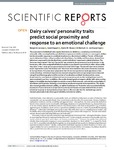Dairy calves' personality traits predict social proximity and response to an emotional challenge
| dc.contributor.author | Lecorps, B | |
| dc.contributor.author | Kappel, Sarah | |
| dc.contributor.author | Weary, DM | |
| dc.contributor.author | von Keyserlingk, MAG | |
| dc.date.accessioned | 2019-01-21T09:18:29Z | |
| dc.date.issued | 2018-11-05 | |
| dc.identifier.issn | 2045-2322 | |
| dc.identifier.issn | 2045-2322 | |
| dc.identifier.other | ARTN 16350 | |
| dc.identifier.uri | http://hdl.handle.net/10026.1/13166 | |
| dc.description.abstract |
The assessment of individual traits requires that tests are reliable (i.e. consistency over time) and externally valid, meaning that they predict future responses in similar contexts (i.e. convergent validity) but do not predict responses to unrelated situations (i.e. discriminant validity). The aim of this study was to determine if dairy calf personality traits (Fearfulness, Sociability and Pessimism), derived from behaviours expressed in standardized tests, predict individuals’ responses in related situations. The first experiment tested if the trait ‘Sociability’ was related to the expression of social behaviour in the home-pen, with calves assigned individual proximity scores (based on proximity to other calves) while they were in their home-pen at approximately 113 and 118 d of age. The second experiment aimed at exploring whether traits ‘Fearfulness’ and ‘Pessimism’ were related to the calves’ emotional response to transportation. All calves were subjected to two 10-min transportation challenges done on two consecutive days. Emotional response was assessed using the maximum eye temperature (measured using infrared thermography) and the number of vocalizations emitted. Social proximity scores (Experiment 1), vocalizations emitted and maximum eye temperature after loading (Experiment 2) were consistent over time. In addition, the results showed good convergent validity with calves scoring higher in Sociability also having higher proximity scores in the home-pen, and animals scoring higher in Fearfulness and Pessimism showing a more intense emotional response to transportation. The results also showed good discriminant validity, as neither Fearfulness nor Pessimism were associated with the expression of social behaviours (Experiment 1) and Sociability was not associated with the animal’s emotional response to transportation (Experiment 2). We conclude that the methodology used to measure personality traits shows good reliability and external validity. | |
| dc.format.extent | 16350- | |
| dc.format.medium | Electronic | |
| dc.language | en | |
| dc.language.iso | en | |
| dc.publisher | Nature Research (part of Springer Nature) | |
| dc.subject | Animals | |
| dc.subject | Behavior, Animal | |
| dc.subject | Cattle | |
| dc.subject | Dairying | |
| dc.subject | Emotions | |
| dc.subject | Fear | |
| dc.subject | Personality | |
| dc.subject | Pessimism | |
| dc.subject | Social Behavior | |
| dc.subject | Stress, Psychological | |
| dc.title | Dairy calves' personality traits predict social proximity and response to an emotional challenge | |
| dc.type | journal-article | |
| dc.type | Journal Article | |
| dc.type | Research Support, Non-U.S. Gov't | |
| plymouth.author-url | http://gateway.webofknowledge.com/gateway/Gateway.cgi?GWVersion=2&SrcApp=PARTNER_APP&SrcAuth=LinksAMR&KeyUT=WOS:000449272100044&DestLinkType=FullRecord&DestApp=ALL_WOS&UsrCustomerID=11bb513d99f797142bcfeffcc58ea008 | |
| plymouth.issue | 1 | |
| plymouth.volume | 8 | |
| plymouth.publication-status | Published online | |
| plymouth.journal | Scientific Reports | |
| dc.identifier.doi | 10.1038/s41598-018-34281-2 | |
| plymouth.organisational-group | /Plymouth | |
| plymouth.organisational-group | /Plymouth/Faculty of Science and Engineering | |
| plymouth.organisational-group | /Plymouth/Users by role | |
| plymouth.organisational-group | /Plymouth/Users by role/Academics | |
| dc.publisher.place | England | |
| dcterms.dateAccepted | 2018-10-06 | |
| dc.rights.embargodate | 2019-12-18 | |
| dc.identifier.eissn | 2045-2322 | |
| dc.rights.embargoperiod | Not known | |
| rioxxterms.versionofrecord | 10.1038/s41598-018-34281-2 | |
| rioxxterms.licenseref.uri | http://www.rioxx.net/licenses/all-rights-reserved | |
| rioxxterms.licenseref.startdate | 2018-11-05 | |
| rioxxterms.type | Journal Article/Review |


